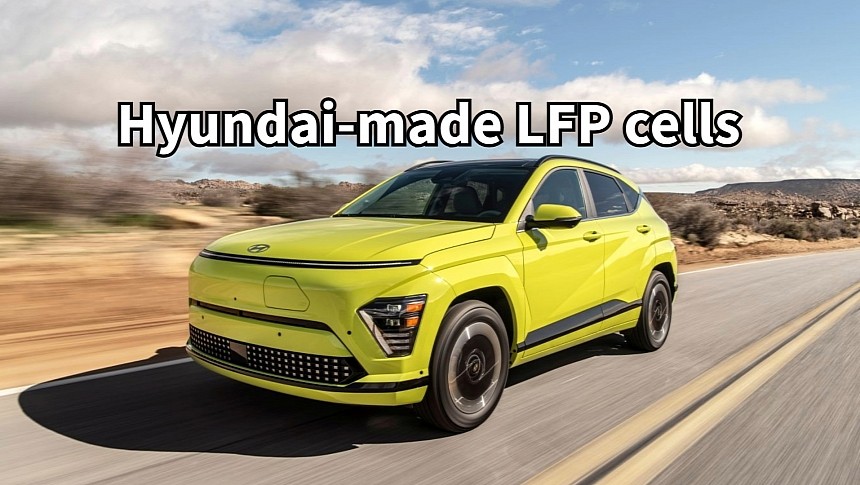As carmakers struggle to make their EVs more affordable, the lithium-iron-phosphate (LFP) batteries are projected to dominate the market. The latest to join the fray is Hyundai, which will produce its own LFP battery cells in 2025.
The battery pack is the most expensive component in an electric vehicle, making it an ideal cost-cutting target. While the raw material prices have been roller-coasting in the past couple of years, they are now consistently trending lower. This is projected to continue into 2024 as EV adoption is slowing down in most car markets. So far, EV battery cells are priced at about $75/kWh at cell level, well below the $100 threshold believed to mark the price parity with ICE vehicles.
Electric vehicles are still not cheap enough, mostly because of the enormous investments needed to switch production from ICE vehicles to EVs. Major carmakers like GM and Ford have slowed down their EV programs because the huge costs of setting up new battery and EV factories tanked their financial results. An affordable battery cell type emerges as the undisputed cost champion in this struggle to reach profitability.
Lithium-iron-phosphate (LFP) cells don't need expensive (and rare) raw materials like nickel and cobalt, making them cheaper. However, they have a significant drawback: the lower energy density. The gap with the ternary cells (nickel-manganese-cobalt or NMC is the most popular ternary chemistry these days) has been narrowing fast as battery producers fine-tune LFP chemistry and improve packaging. That's why the LFP cells are increasingly popular, especially for the most affordable EV models.
LFP cells are used by most EV makers, including Tesla, and more will jump on the bandwagon in the coming years. Hyundai is one of them, according to a recent report from Korea. Unlike other carmakers, which partnered with Chinese battery producers for their LFP cell programs, Hyundai is developing its LFP cells in partnership with Korean battery manufacturers. This has the benefit of reducing the reliance on Chinese suppliers and offering more affordable EV models to its customers.
The Korea Herald reports the new LFP cells will be installed in Hyundai's entry-level EVs as early as 2025. Currently, Hyundai makes the Kona EV with LFP cells supplied by CATL from China. The news outlet claims Hyundai achieved an energy density of 300 Wh per kilogram for its LFP cells, which is very impressive if true. Moreover, Hyundai thinks it can improve LFP cells' energy density to get on par with premium NMC cells.
In June, Hyundai pledged to invest $7.3 billion in EV battery development and technologies over the next ten years. These include developing LFP, NCM, and solid-state batteries in partnership with Korean battery manufacturers and academic institutions. The plan yielded the first Hyundai-made NCM cells, which are now installed in the hybrid version of the Hyundai Santa Fe, launched in August.
Electric vehicles are still not cheap enough, mostly because of the enormous investments needed to switch production from ICE vehicles to EVs. Major carmakers like GM and Ford have slowed down their EV programs because the huge costs of setting up new battery and EV factories tanked their financial results. An affordable battery cell type emerges as the undisputed cost champion in this struggle to reach profitability.
Lithium-iron-phosphate (LFP) cells don't need expensive (and rare) raw materials like nickel and cobalt, making them cheaper. However, they have a significant drawback: the lower energy density. The gap with the ternary cells (nickel-manganese-cobalt or NMC is the most popular ternary chemistry these days) has been narrowing fast as battery producers fine-tune LFP chemistry and improve packaging. That's why the LFP cells are increasingly popular, especially for the most affordable EV models.
LFP cells are used by most EV makers, including Tesla, and more will jump on the bandwagon in the coming years. Hyundai is one of them, according to a recent report from Korea. Unlike other carmakers, which partnered with Chinese battery producers for their LFP cell programs, Hyundai is developing its LFP cells in partnership with Korean battery manufacturers. This has the benefit of reducing the reliance on Chinese suppliers and offering more affordable EV models to its customers.
The Korea Herald reports the new LFP cells will be installed in Hyundai's entry-level EVs as early as 2025. Currently, Hyundai makes the Kona EV with LFP cells supplied by CATL from China. The news outlet claims Hyundai achieved an energy density of 300 Wh per kilogram for its LFP cells, which is very impressive if true. Moreover, Hyundai thinks it can improve LFP cells' energy density to get on par with premium NMC cells.
In June, Hyundai pledged to invest $7.3 billion in EV battery development and technologies over the next ten years. These include developing LFP, NCM, and solid-state batteries in partnership with Korean battery manufacturers and academic institutions. The plan yielded the first Hyundai-made NCM cells, which are now installed in the hybrid version of the Hyundai Santa Fe, launched in August.






